Personal Responsibility in Fashion and Clothes: A Detailed Report
VerifiedAdded on 2020/06/06
|11
|2689
|299
Report
AI Summary
This report delves into the multifaceted aspects of personal and corporate responsibility within the fashion industry, using H&M as a case study. It begins by exploring the personal significance of fashion, individual purchasing criteria, and the influence of fashion icons. The report then transitions to a stakeholder analysis of the fashion industry, followed by a detailed examination of the life cycle assessment of clothing, highlighting the environmental impact of various stages from raw material acquisition to end-of-life disposal. The core of the report focuses on corporate social responsibility (CSR), specifically H&M's approach to ethics, sustainability, and its initiatives related to people and the planet. It concludes with recommendations for more sustainable fashion habits, including alternatives, and suggestions for H&M to enhance its sustainability practices, along with an overview of sustainable business models in the fashion industry. The report emphasizes the importance of ethical considerations, transparency, and the adoption of practices like fair trade and organic cotton to minimize the environmental footprint and promote responsible consumption.
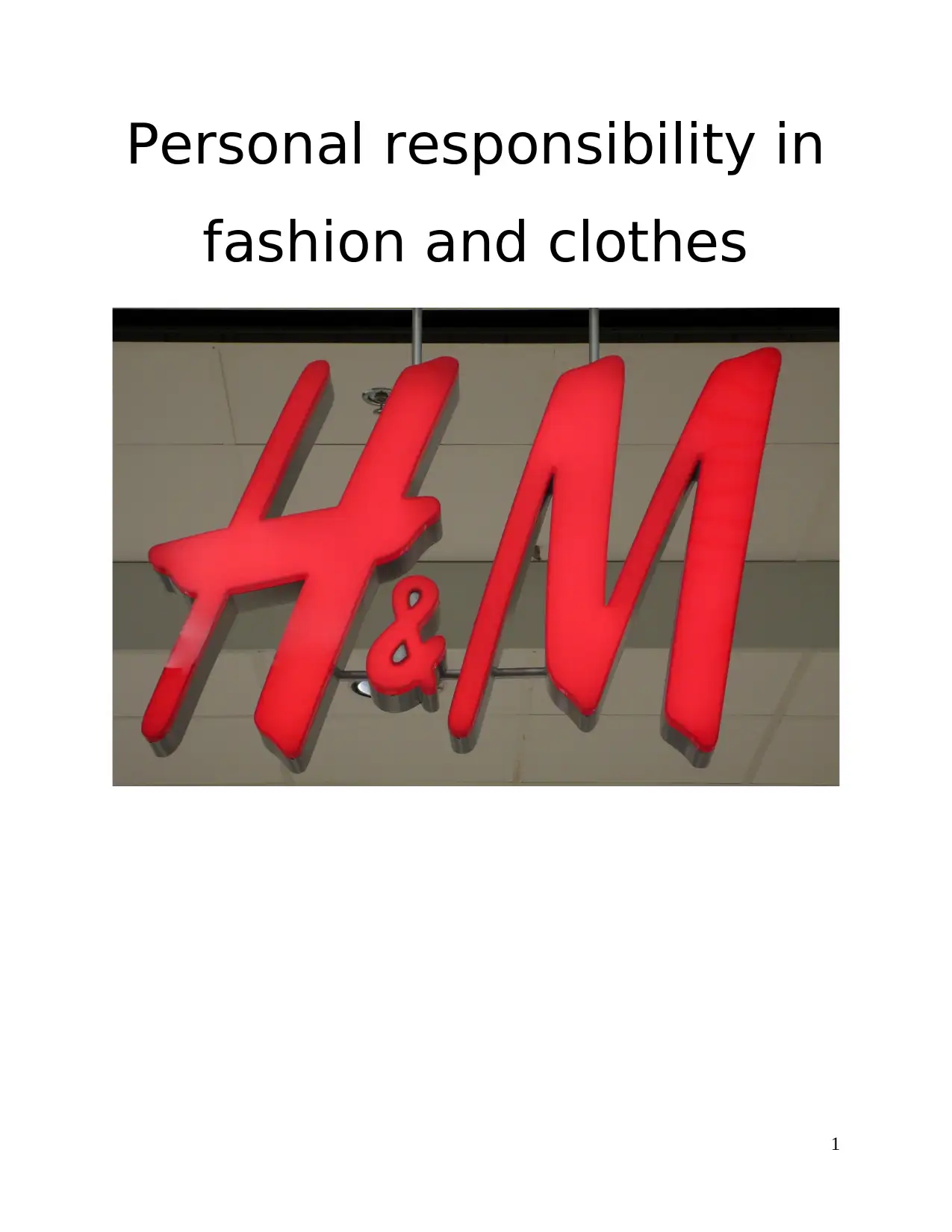
Personal responsibility in
fashion and clothes
1
fashion and clothes
1
Secure Best Marks with AI Grader
Need help grading? Try our AI Grader for instant feedback on your assignments.
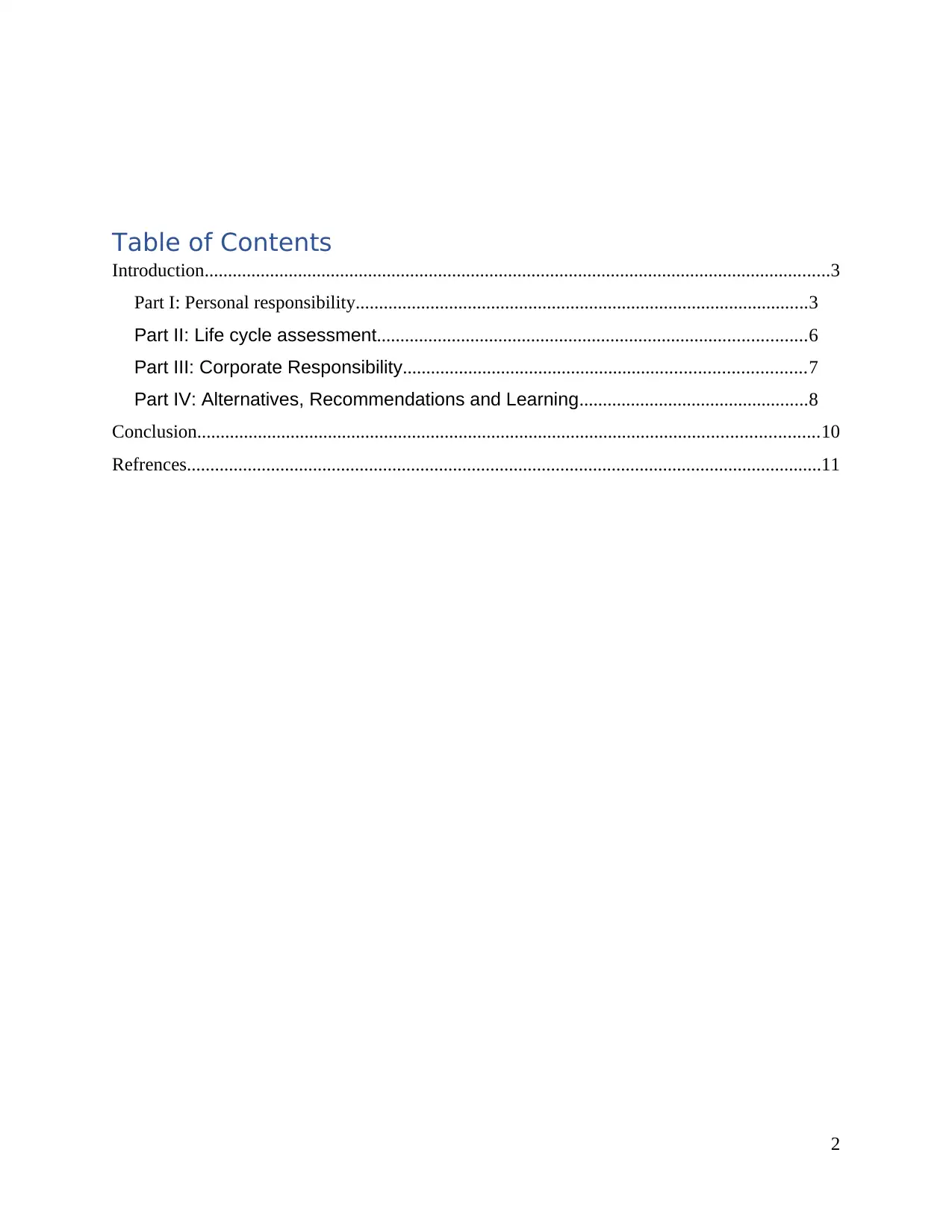
Table of Contents
Introduction......................................................................................................................................3
Part I: Personal responsibility.................................................................................................3
Part II: Life cycle assessment............................................................................................6
Part III: Corporate Responsibility......................................................................................7
Part IV: Alternatives, Recommendations and Learning.................................................8
Conclusion.....................................................................................................................................10
Refrences........................................................................................................................................11
2
Introduction......................................................................................................................................3
Part I: Personal responsibility.................................................................................................3
Part II: Life cycle assessment............................................................................................6
Part III: Corporate Responsibility......................................................................................7
Part IV: Alternatives, Recommendations and Learning.................................................8
Conclusion.....................................................................................................................................10
Refrences........................................................................................................................................11
2
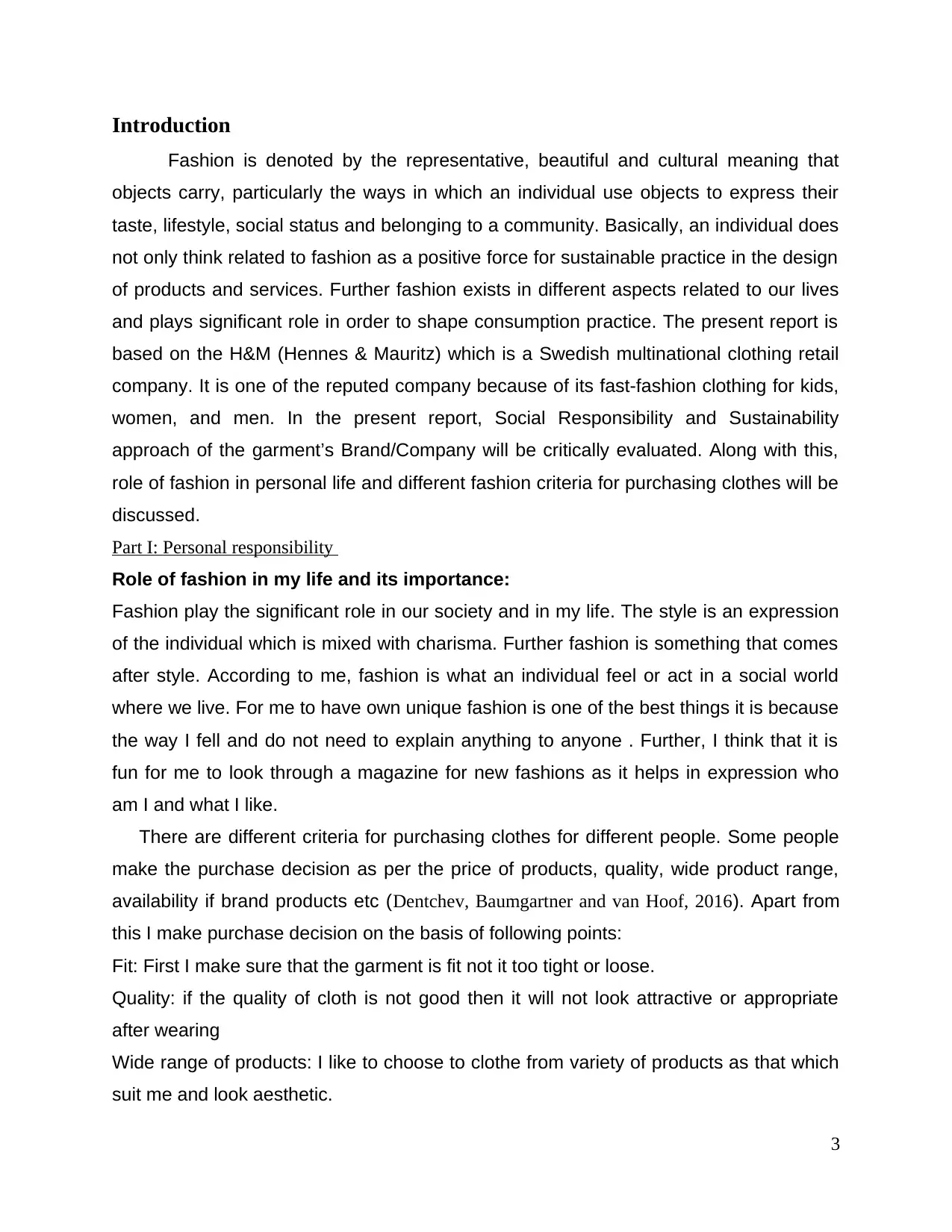
Introduction
Fashion is denoted by the representative, beautiful and cultural meaning that
objects carry, particularly the ways in which an individual use objects to express their
taste, lifestyle, social status and belonging to a community. Basically, an individual does
not only think related to fashion as a positive force for sustainable practice in the design
of products and services. Further fashion exists in different aspects related to our lives
and plays significant role in order to shape consumption practice. The present report is
based on the H&M (Hennes & Mauritz) which is a Swedish multinational clothing retail
company. It is one of the reputed company because of its fast-fashion clothing for kids,
women, and men. In the present report, Social Responsibility and Sustainability
approach of the garment’s Brand/Company will be critically evaluated. Along with this,
role of fashion in personal life and different fashion criteria for purchasing clothes will be
discussed.
Part I: Personal responsibility
Role of fashion in my life and its importance:
Fashion play the significant role in our society and in my life. The style is an expression
of the individual which is mixed with charisma. Further fashion is something that comes
after style. According to me, fashion is what an individual feel or act in a social world
where we live. For me to have own unique fashion is one of the best things it is because
the way I fell and do not need to explain anything to anyone . Further, I think that it is
fun for me to look through a magazine for new fashions as it helps in expression who
am I and what I like.
There are different criteria for purchasing clothes for different people. Some people
make the purchase decision as per the price of products, quality, wide product range,
availability if brand products etc (Dentchev, Baumgartner and van Hoof, 2016). Apart from
this I make purchase decision on the basis of following points:
Fit: First I make sure that the garment is fit not it too tight or loose.
Quality: if the quality of cloth is not good then it will not look attractive or appropriate
after wearing
Wide range of products: I like to choose to clothe from variety of products as that which
suit me and look aesthetic.
3
Fashion is denoted by the representative, beautiful and cultural meaning that
objects carry, particularly the ways in which an individual use objects to express their
taste, lifestyle, social status and belonging to a community. Basically, an individual does
not only think related to fashion as a positive force for sustainable practice in the design
of products and services. Further fashion exists in different aspects related to our lives
and plays significant role in order to shape consumption practice. The present report is
based on the H&M (Hennes & Mauritz) which is a Swedish multinational clothing retail
company. It is one of the reputed company because of its fast-fashion clothing for kids,
women, and men. In the present report, Social Responsibility and Sustainability
approach of the garment’s Brand/Company will be critically evaluated. Along with this,
role of fashion in personal life and different fashion criteria for purchasing clothes will be
discussed.
Part I: Personal responsibility
Role of fashion in my life and its importance:
Fashion play the significant role in our society and in my life. The style is an expression
of the individual which is mixed with charisma. Further fashion is something that comes
after style. According to me, fashion is what an individual feel or act in a social world
where we live. For me to have own unique fashion is one of the best things it is because
the way I fell and do not need to explain anything to anyone . Further, I think that it is
fun for me to look through a magazine for new fashions as it helps in expression who
am I and what I like.
There are different criteria for purchasing clothes for different people. Some people
make the purchase decision as per the price of products, quality, wide product range,
availability if brand products etc (Dentchev, Baumgartner and van Hoof, 2016). Apart from
this I make purchase decision on the basis of following points:
Fit: First I make sure that the garment is fit not it too tight or loose.
Quality: if the quality of cloth is not good then it will not look attractive or appropriate
after wearing
Wide range of products: I like to choose to clothe from variety of products as that which
suit me and look aesthetic.
3
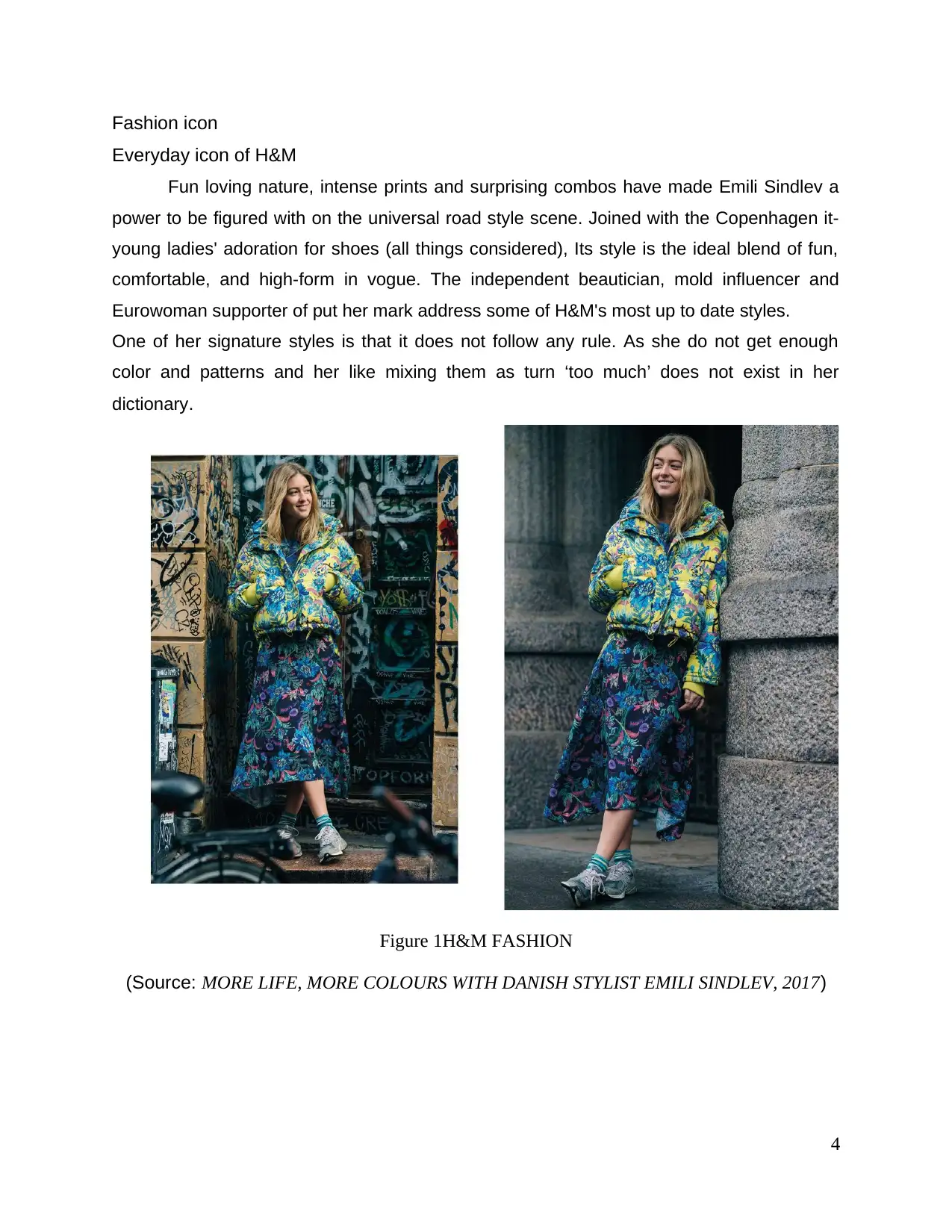
Fashion icon
Everyday icon of H&M
Fun loving nature, intense prints and surprising combos have made Emili Sindlev a
power to be figured with on the universal road style scene. Joined with the Copenhagen it-
young ladies' adoration for shoes (all things considered), Its style is the ideal blend of fun,
comfortable, and high-form in vogue. The independent beautician, mold influencer and
Eurowoman supporter of put her mark address some of H&M's most up to date styles.
One of her signature styles is that it does not follow any rule. As she do not get enough
color and patterns and her like mixing them as turn ‘too much’ does not exist in her
dictionary.
Figure 1H&M FASHION
(Source: MORE LIFE, MORE COLOURS WITH DANISH STYLIST EMILI SINDLEV, 2017)
4
Everyday icon of H&M
Fun loving nature, intense prints and surprising combos have made Emili Sindlev a
power to be figured with on the universal road style scene. Joined with the Copenhagen it-
young ladies' adoration for shoes (all things considered), Its style is the ideal blend of fun,
comfortable, and high-form in vogue. The independent beautician, mold influencer and
Eurowoman supporter of put her mark address some of H&M's most up to date styles.
One of her signature styles is that it does not follow any rule. As she do not get enough
color and patterns and her like mixing them as turn ‘too much’ does not exist in her
dictionary.
Figure 1H&M FASHION
(Source: MORE LIFE, MORE COLOURS WITH DANISH STYLIST EMILI SINDLEV, 2017)
4
Secure Best Marks with AI Grader
Need help grading? Try our AI Grader for instant feedback on your assignments.
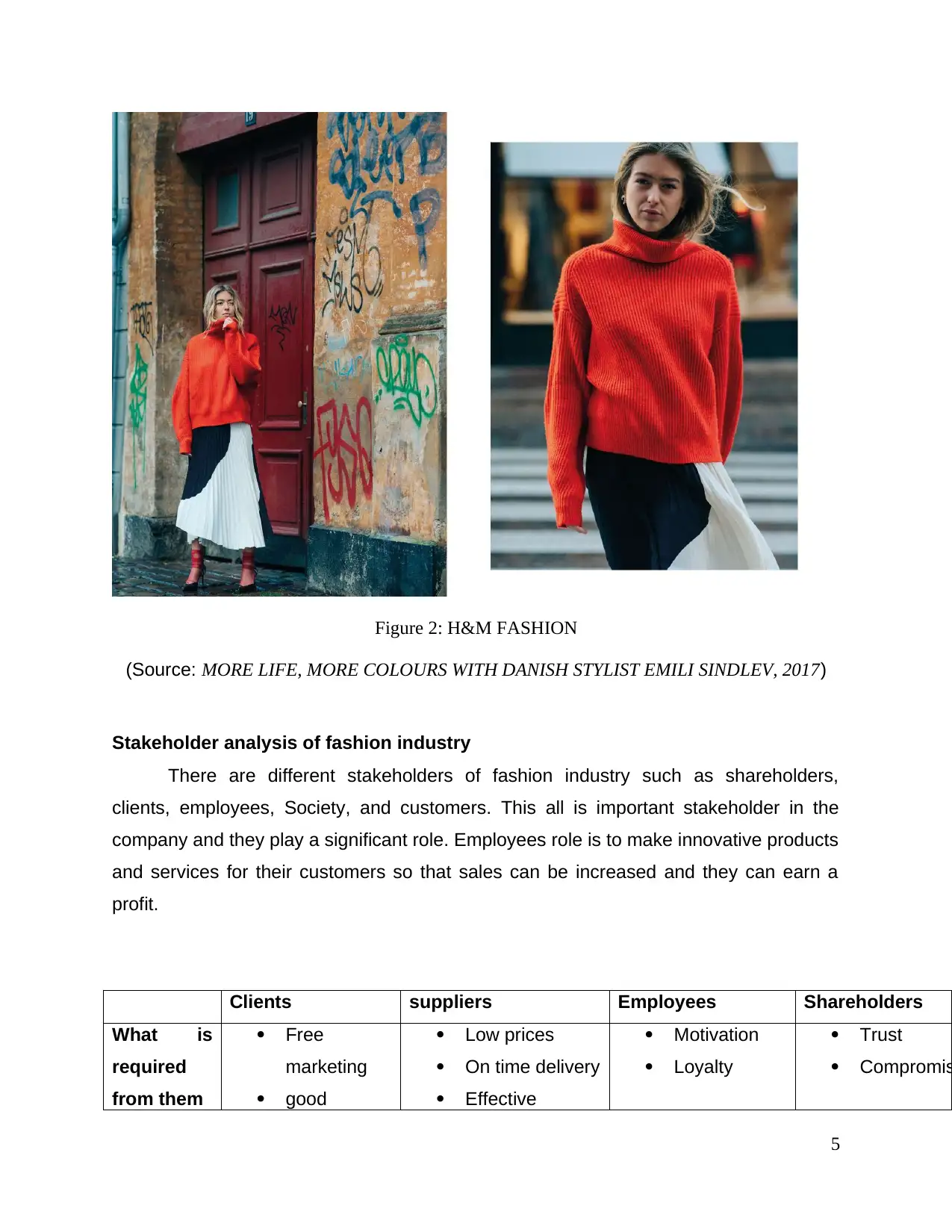
Figure 2: H&M FASHION
(Source: MORE LIFE, MORE COLOURS WITH DANISH STYLIST EMILI SINDLEV, 2017)
Stakeholder analysis of fashion industry
There are different stakeholders of fashion industry such as shareholders,
clients, employees, Society, and customers. This all is important stakeholder in the
company and they play a significant role. Employees role is to make innovative products
and services for their customers so that sales can be increased and they can earn a
profit.
Clients suppliers Employees Shareholders
What is
required
from them
Free
marketing
good
Low prices
On time delivery
Effective
Motivation
Loyalty
Trust
Compromis
5
(Source: MORE LIFE, MORE COLOURS WITH DANISH STYLIST EMILI SINDLEV, 2017)
Stakeholder analysis of fashion industry
There are different stakeholders of fashion industry such as shareholders,
clients, employees, Society, and customers. This all is important stakeholder in the
company and they play a significant role. Employees role is to make innovative products
and services for their customers so that sales can be increased and they can earn a
profit.
Clients suppliers Employees Shareholders
What is
required
from them
Free
marketing
good
Low prices
On time delivery
Effective
Motivation
Loyalty
Trust
Compromis
5
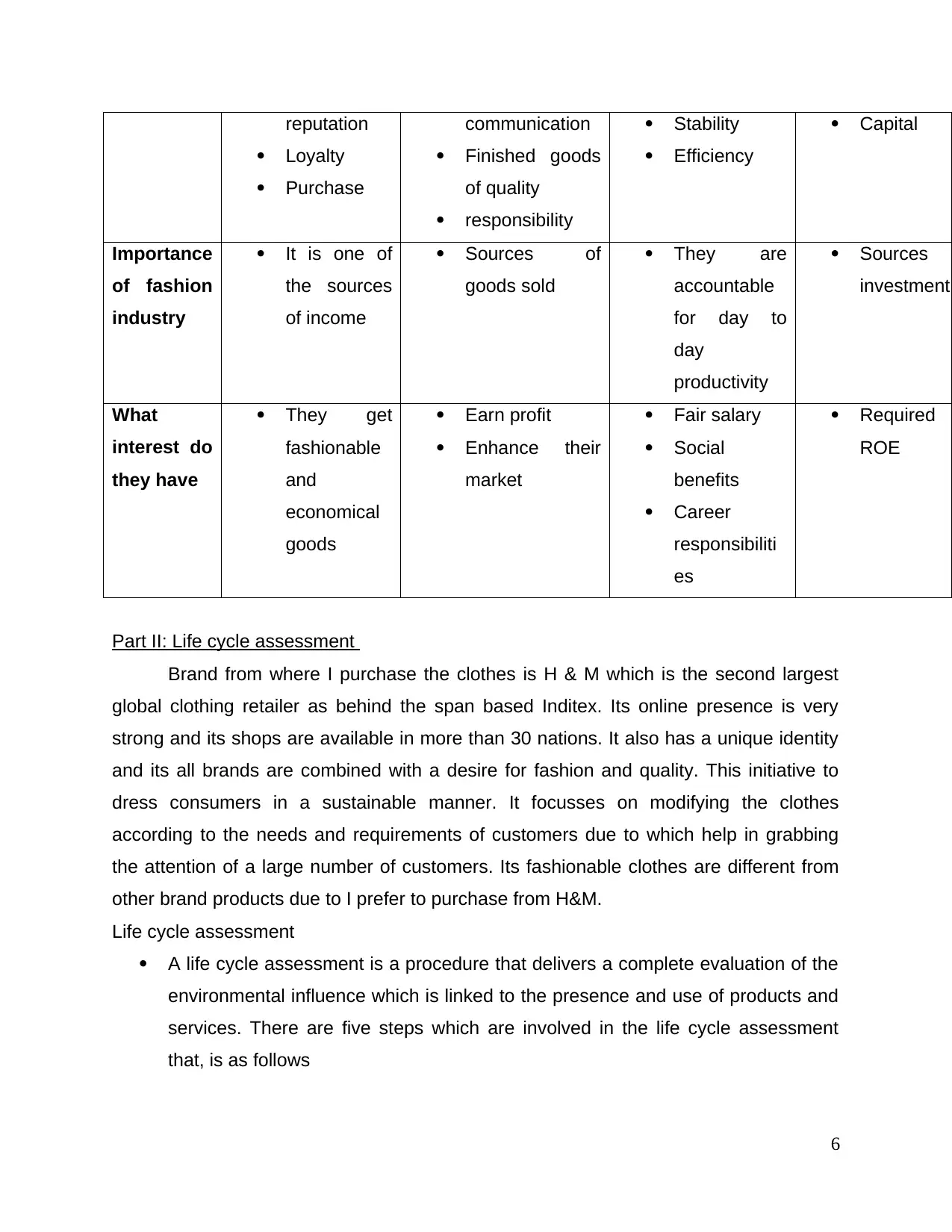
reputation
Loyalty
Purchase
communication
Finished goods
of quality
responsibility
Stability
Efficiency
Capital
Importance
of fashion
industry
It is one of
the sources
of income
Sources of
goods sold
They are
accountable
for day to
day
productivity
Sources
investment
What
interest do
they have
They get
fashionable
and
economical
goods
Earn profit
Enhance their
market
Fair salary
Social
benefits
Career
responsibiliti
es
Required
ROE
Part II: Life cycle assessment
Brand from where I purchase the clothes is H & M which is the second largest
global clothing retailer as behind the span based Inditex. Its online presence is very
strong and its shops are available in more than 30 nations. It also has a unique identity
and its all brands are combined with a desire for fashion and quality. This initiative to
dress consumers in a sustainable manner. It focusses on modifying the clothes
according to the needs and requirements of customers due to which help in grabbing
the attention of a large number of customers. Its fashionable clothes are different from
other brand products due to I prefer to purchase from H&M.
Life cycle assessment
A life cycle assessment is a procedure that delivers a complete evaluation of the
environmental influence which is linked to the presence and use of products and
services. There are five steps which are involved in the life cycle assessment
that, is as follows
6
Loyalty
Purchase
communication
Finished goods
of quality
responsibility
Stability
Efficiency
Capital
Importance
of fashion
industry
It is one of
the sources
of income
Sources of
goods sold
They are
accountable
for day to
day
productivity
Sources
investment
What
interest do
they have
They get
fashionable
and
economical
goods
Earn profit
Enhance their
market
Fair salary
Social
benefits
Career
responsibiliti
es
Required
ROE
Part II: Life cycle assessment
Brand from where I purchase the clothes is H & M which is the second largest
global clothing retailer as behind the span based Inditex. Its online presence is very
strong and its shops are available in more than 30 nations. It also has a unique identity
and its all brands are combined with a desire for fashion and quality. This initiative to
dress consumers in a sustainable manner. It focusses on modifying the clothes
according to the needs and requirements of customers due to which help in grabbing
the attention of a large number of customers. Its fashionable clothes are different from
other brand products due to I prefer to purchase from H&M.
Life cycle assessment
A life cycle assessment is a procedure that delivers a complete evaluation of the
environmental influence which is linked to the presence and use of products and
services. There are five steps which are involved in the life cycle assessment
that, is as follows
6
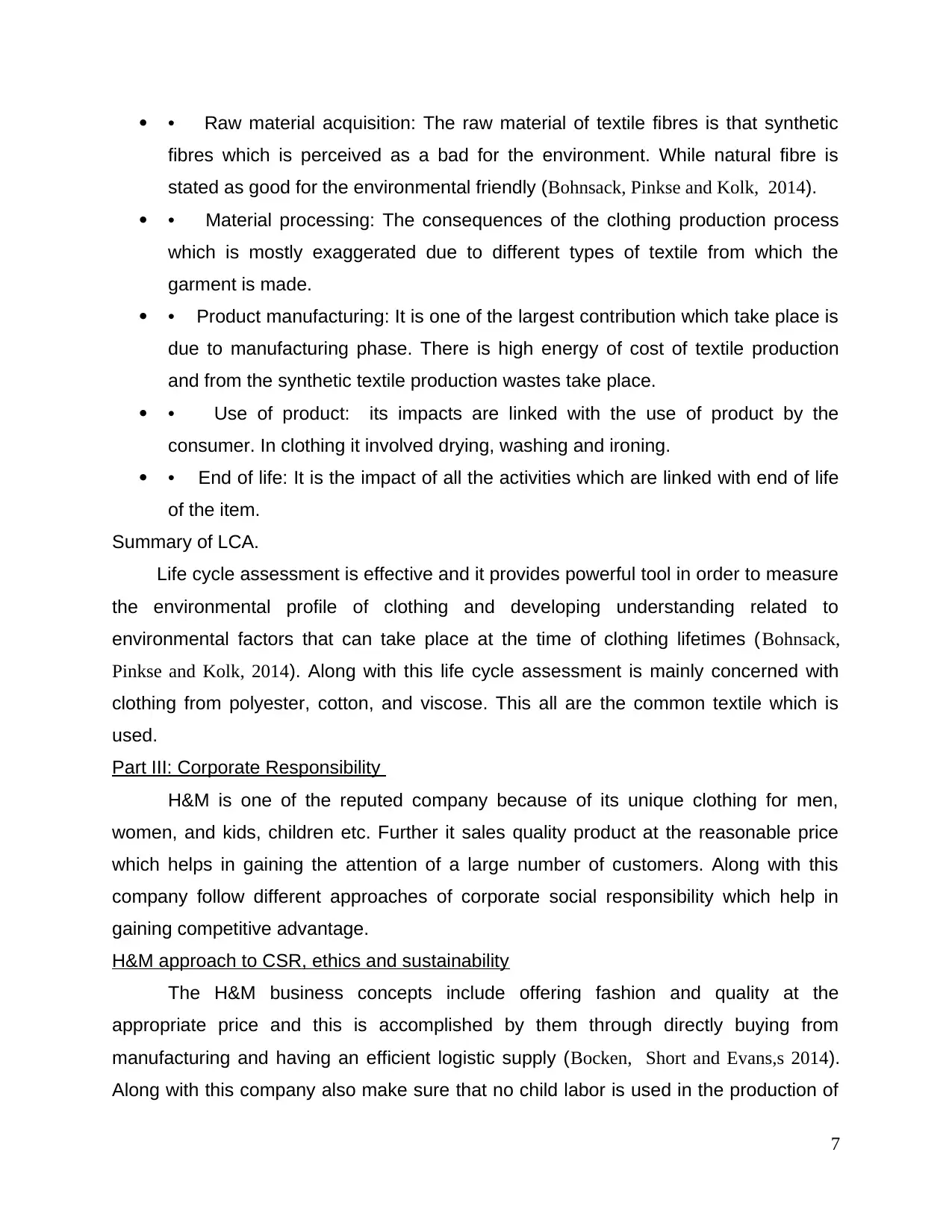
• Raw material acquisition: The raw material of textile fibres is that synthetic
fibres which is perceived as a bad for the environment. While natural fibre is
stated as good for the environmental friendly (Bohnsack, Pinkse and Kolk, 2014).
• Material processing: The consequences of the clothing production process
which is mostly exaggerated due to different types of textile from which the
garment is made.
• Product manufacturing: It is one of the largest contribution which take place is
due to manufacturing phase. There is high energy of cost of textile production
and from the synthetic textile production wastes take place.
• Use of product: its impacts are linked with the use of product by the
consumer. In clothing it involved drying, washing and ironing.
• End of life: It is the impact of all the activities which are linked with end of life
of the item.
Summary of LCA.
Life cycle assessment is effective and it provides powerful tool in order to measure
the environmental profile of clothing and developing understanding related to
environmental factors that can take place at the time of clothing lifetimes (Bohnsack,
Pinkse and Kolk, 2014). Along with this life cycle assessment is mainly concerned with
clothing from polyester, cotton, and viscose. This all are the common textile which is
used.
Part III: Corporate Responsibility
H&M is one of the reputed company because of its unique clothing for men,
women, and kids, children etc. Further it sales quality product at the reasonable price
which helps in gaining the attention of a large number of customers. Along with this
company follow different approaches of corporate social responsibility which help in
gaining competitive advantage.
H&M approach to CSR, ethics and sustainability
The H&M business concepts include offering fashion and quality at the
appropriate price and this is accomplished by them through directly buying from
manufacturing and having an efficient logistic supply (Bocken, Short and Evans,s 2014).
Along with this company also make sure that no child labor is used in the production of
7
fibres which is perceived as a bad for the environment. While natural fibre is
stated as good for the environmental friendly (Bohnsack, Pinkse and Kolk, 2014).
• Material processing: The consequences of the clothing production process
which is mostly exaggerated due to different types of textile from which the
garment is made.
• Product manufacturing: It is one of the largest contribution which take place is
due to manufacturing phase. There is high energy of cost of textile production
and from the synthetic textile production wastes take place.
• Use of product: its impacts are linked with the use of product by the
consumer. In clothing it involved drying, washing and ironing.
• End of life: It is the impact of all the activities which are linked with end of life
of the item.
Summary of LCA.
Life cycle assessment is effective and it provides powerful tool in order to measure
the environmental profile of clothing and developing understanding related to
environmental factors that can take place at the time of clothing lifetimes (Bohnsack,
Pinkse and Kolk, 2014). Along with this life cycle assessment is mainly concerned with
clothing from polyester, cotton, and viscose. This all are the common textile which is
used.
Part III: Corporate Responsibility
H&M is one of the reputed company because of its unique clothing for men,
women, and kids, children etc. Further it sales quality product at the reasonable price
which helps in gaining the attention of a large number of customers. Along with this
company follow different approaches of corporate social responsibility which help in
gaining competitive advantage.
H&M approach to CSR, ethics and sustainability
The H&M business concepts include offering fashion and quality at the
appropriate price and this is accomplished by them through directly buying from
manufacturing and having an efficient logistic supply (Bocken, Short and Evans,s 2014).
Along with this company also make sure that no child labor is used in the production of
7
Paraphrase This Document
Need a fresh take? Get an instant paraphrase of this document with our AI Paraphraser
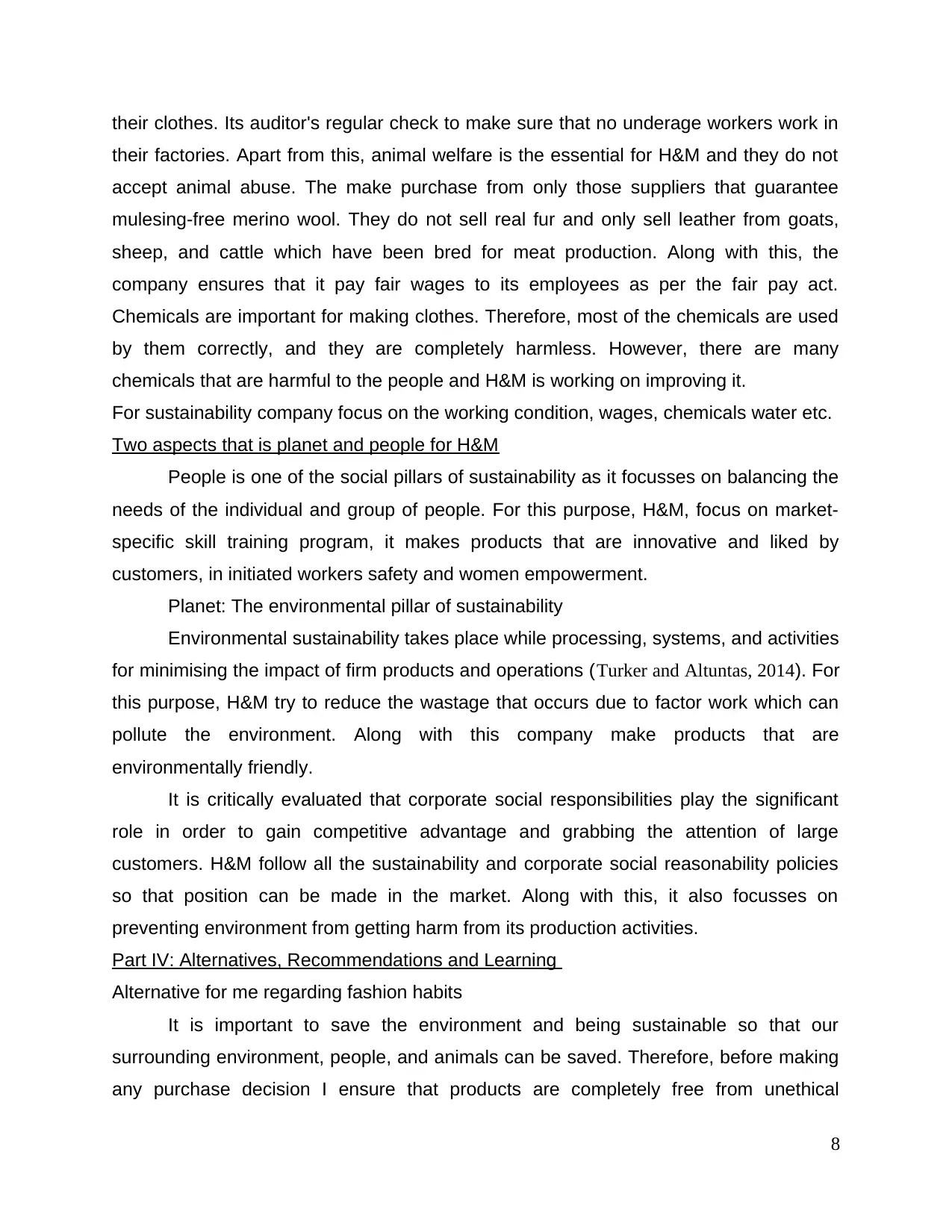
their clothes. Its auditor's regular check to make sure that no underage workers work in
their factories. Apart from this, animal welfare is the essential for H&M and they do not
accept animal abuse. The make purchase from only those suppliers that guarantee
mulesing-free merino wool. They do not sell real fur and only sell leather from goats,
sheep, and cattle which have been bred for meat production. Along with this, the
company ensures that it pay fair wages to its employees as per the fair pay act.
Chemicals are important for making clothes. Therefore, most of the chemicals are used
by them correctly, and they are completely harmless. However, there are many
chemicals that are harmful to the people and H&M is working on improving it.
For sustainability company focus on the working condition, wages, chemicals water etc.
Two aspects that is planet and people for H&M
People is one of the social pillars of sustainability as it focusses on balancing the
needs of the individual and group of people. For this purpose, H&M, focus on market-
specific skill training program, it makes products that are innovative and liked by
customers, in initiated workers safety and women empowerment.
Planet: The environmental pillar of sustainability
Environmental sustainability takes place while processing, systems, and activities
for minimising the impact of firm products and operations (Turker and Altuntas, 2014). For
this purpose, H&M try to reduce the wastage that occurs due to factor work which can
pollute the environment. Along with this company make products that are
environmentally friendly.
It is critically evaluated that corporate social responsibilities play the significant
role in order to gain competitive advantage and grabbing the attention of large
customers. H&M follow all the sustainability and corporate social reasonability policies
so that position can be made in the market. Along with this, it also focusses on
preventing environment from getting harm from its production activities.
Part IV: Alternatives, Recommendations and Learning
Alternative for me regarding fashion habits
It is important to save the environment and being sustainable so that our
surrounding environment, people, and animals can be saved. Therefore, before making
any purchase decision I ensure that products are completely free from unethical
8
their factories. Apart from this, animal welfare is the essential for H&M and they do not
accept animal abuse. The make purchase from only those suppliers that guarantee
mulesing-free merino wool. They do not sell real fur and only sell leather from goats,
sheep, and cattle which have been bred for meat production. Along with this, the
company ensures that it pay fair wages to its employees as per the fair pay act.
Chemicals are important for making clothes. Therefore, most of the chemicals are used
by them correctly, and they are completely harmless. However, there are many
chemicals that are harmful to the people and H&M is working on improving it.
For sustainability company focus on the working condition, wages, chemicals water etc.
Two aspects that is planet and people for H&M
People is one of the social pillars of sustainability as it focusses on balancing the
needs of the individual and group of people. For this purpose, H&M, focus on market-
specific skill training program, it makes products that are innovative and liked by
customers, in initiated workers safety and women empowerment.
Planet: The environmental pillar of sustainability
Environmental sustainability takes place while processing, systems, and activities
for minimising the impact of firm products and operations (Turker and Altuntas, 2014). For
this purpose, H&M try to reduce the wastage that occurs due to factor work which can
pollute the environment. Along with this company make products that are
environmentally friendly.
It is critically evaluated that corporate social responsibilities play the significant
role in order to gain competitive advantage and grabbing the attention of large
customers. H&M follow all the sustainability and corporate social reasonability policies
so that position can be made in the market. Along with this, it also focusses on
preventing environment from getting harm from its production activities.
Part IV: Alternatives, Recommendations and Learning
Alternative for me regarding fashion habits
It is important to save the environment and being sustainable so that our
surrounding environment, people, and animals can be saved. Therefore, before making
any purchase decision I ensure that products are completely free from unethical
8
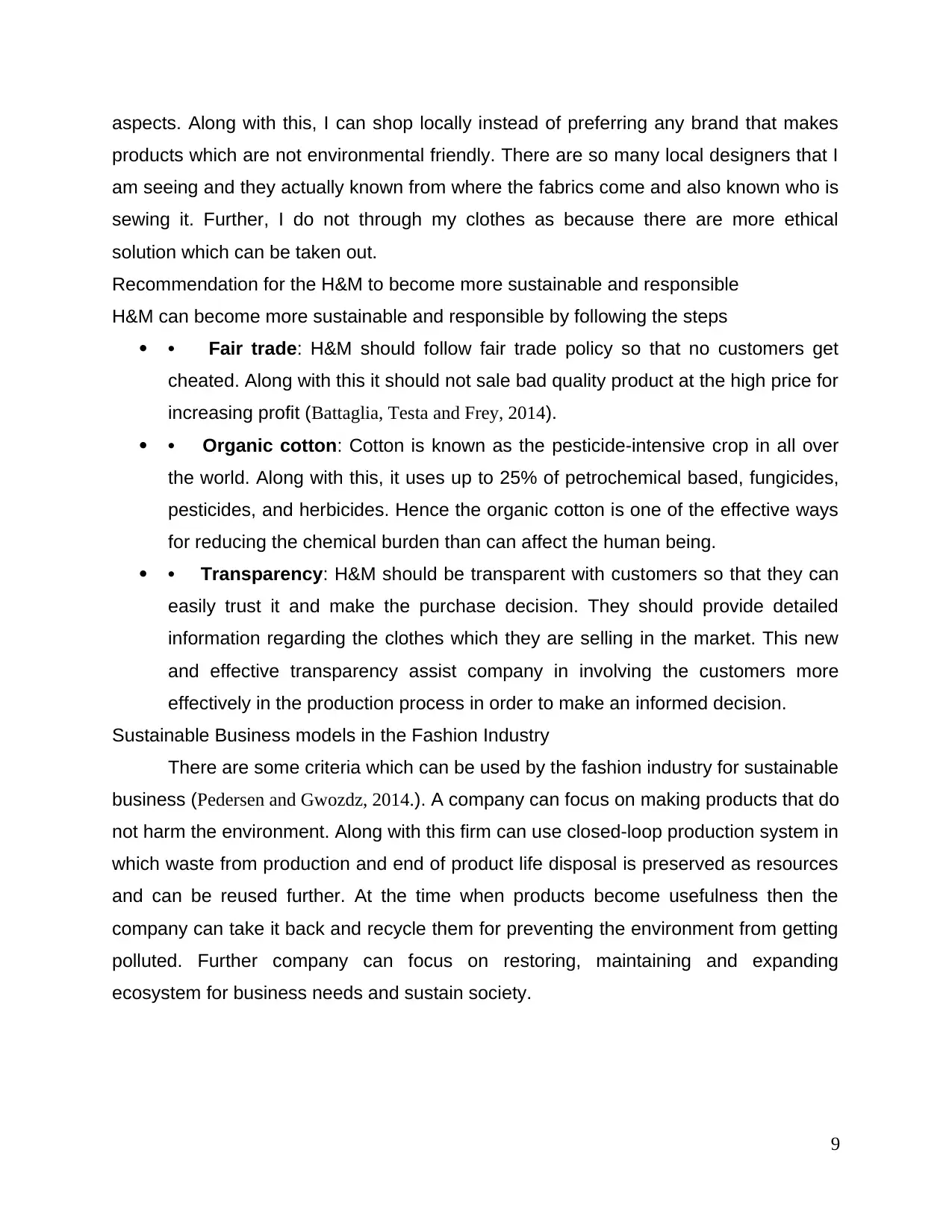
aspects. Along with this, I can shop locally instead of preferring any brand that makes
products which are not environmental friendly. There are so many local designers that I
am seeing and they actually known from where the fabrics come and also known who is
sewing it. Further, I do not through my clothes as because there are more ethical
solution which can be taken out.
Recommendation for the H&M to become more sustainable and responsible
H&M can become more sustainable and responsible by following the steps
• Fair trade: H&M should follow fair trade policy so that no customers get
cheated. Along with this it should not sale bad quality product at the high price for
increasing profit (Battaglia, Testa and Frey, 2014).
• Organic cotton: Cotton is known as the pesticide-intensive crop in all over
the world. Along with this, it uses up to 25% of petrochemical based, fungicides,
pesticides, and herbicides. Hence the organic cotton is one of the effective ways
for reducing the chemical burden than can affect the human being.
• Transparency: H&M should be transparent with customers so that they can
easily trust it and make the purchase decision. They should provide detailed
information regarding the clothes which they are selling in the market. This new
and effective transparency assist company in involving the customers more
effectively in the production process in order to make an informed decision.
Sustainable Business models in the Fashion Industry
There are some criteria which can be used by the fashion industry for sustainable
business (Pedersen and Gwozdz, 2014.). A company can focus on making products that do
not harm the environment. Along with this firm can use closed-loop production system in
which waste from production and end of product life disposal is preserved as resources
and can be reused further. At the time when products become usefulness then the
company can take it back and recycle them for preventing the environment from getting
polluted. Further company can focus on restoring, maintaining and expanding
ecosystem for business needs and sustain society.
9
products which are not environmental friendly. There are so many local designers that I
am seeing and they actually known from where the fabrics come and also known who is
sewing it. Further, I do not through my clothes as because there are more ethical
solution which can be taken out.
Recommendation for the H&M to become more sustainable and responsible
H&M can become more sustainable and responsible by following the steps
• Fair trade: H&M should follow fair trade policy so that no customers get
cheated. Along with this it should not sale bad quality product at the high price for
increasing profit (Battaglia, Testa and Frey, 2014).
• Organic cotton: Cotton is known as the pesticide-intensive crop in all over
the world. Along with this, it uses up to 25% of petrochemical based, fungicides,
pesticides, and herbicides. Hence the organic cotton is one of the effective ways
for reducing the chemical burden than can affect the human being.
• Transparency: H&M should be transparent with customers so that they can
easily trust it and make the purchase decision. They should provide detailed
information regarding the clothes which they are selling in the market. This new
and effective transparency assist company in involving the customers more
effectively in the production process in order to make an informed decision.
Sustainable Business models in the Fashion Industry
There are some criteria which can be used by the fashion industry for sustainable
business (Pedersen and Gwozdz, 2014.). A company can focus on making products that do
not harm the environment. Along with this firm can use closed-loop production system in
which waste from production and end of product life disposal is preserved as resources
and can be reused further. At the time when products become usefulness then the
company can take it back and recycle them for preventing the environment from getting
polluted. Further company can focus on restoring, maintaining and expanding
ecosystem for business needs and sustain society.
9
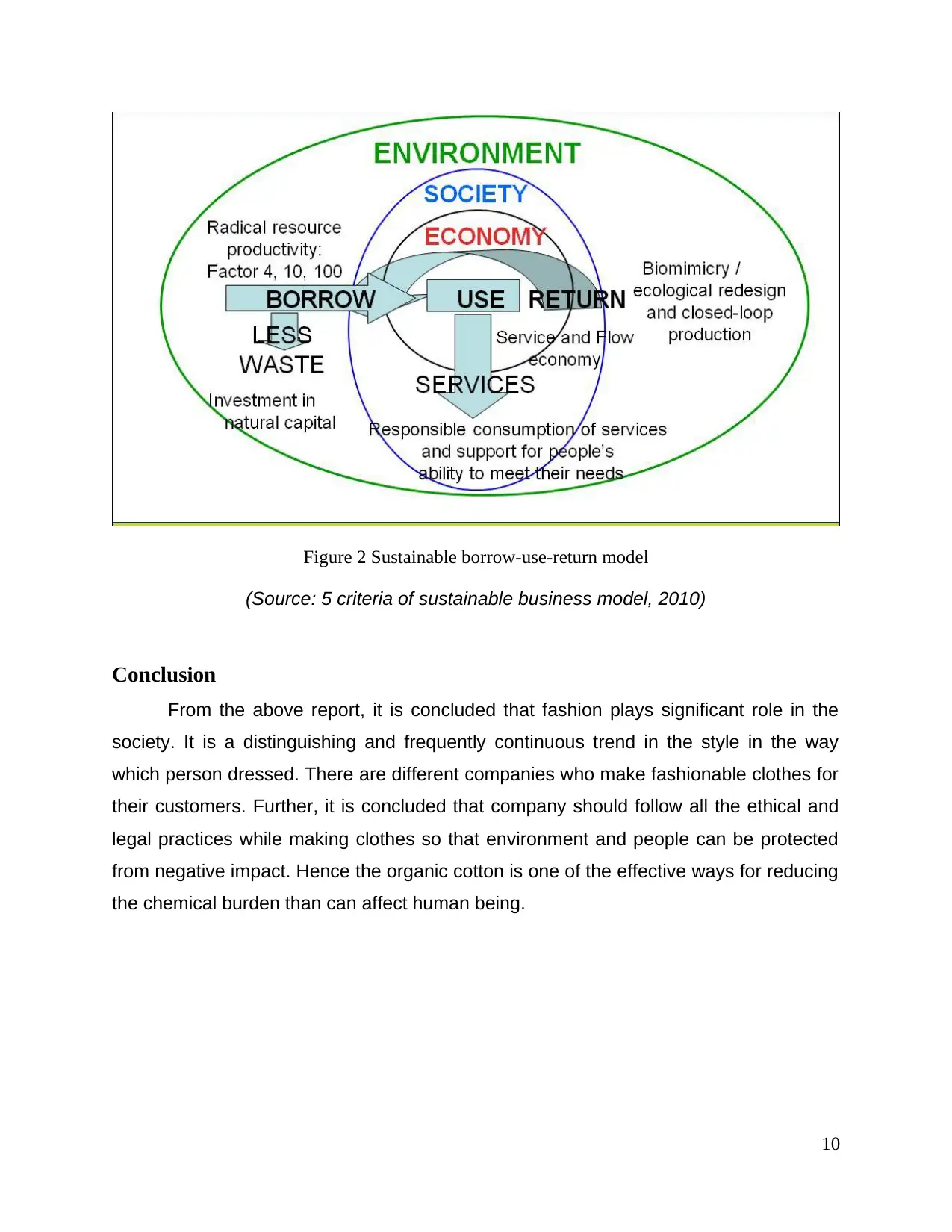
Figure 2 Sustainable borrow-use-return model
(Source: 5 criteria of sustainable business model, 2010)
Conclusion
From the above report, it is concluded that fashion plays significant role in the
society. It is a distinguishing and frequently continuous trend in the style in the way
which person dressed. There are different companies who make fashionable clothes for
their customers. Further, it is concluded that company should follow all the ethical and
legal practices while making clothes so that environment and people can be protected
from negative impact. Hence the organic cotton is one of the effective ways for reducing
the chemical burden than can affect human being.
10
(Source: 5 criteria of sustainable business model, 2010)
Conclusion
From the above report, it is concluded that fashion plays significant role in the
society. It is a distinguishing and frequently continuous trend in the style in the way
which person dressed. There are different companies who make fashionable clothes for
their customers. Further, it is concluded that company should follow all the ethical and
legal practices while making clothes so that environment and people can be protected
from negative impact. Hence the organic cotton is one of the effective ways for reducing
the chemical burden than can affect human being.
10
Secure Best Marks with AI Grader
Need help grading? Try our AI Grader for instant feedback on your assignments.
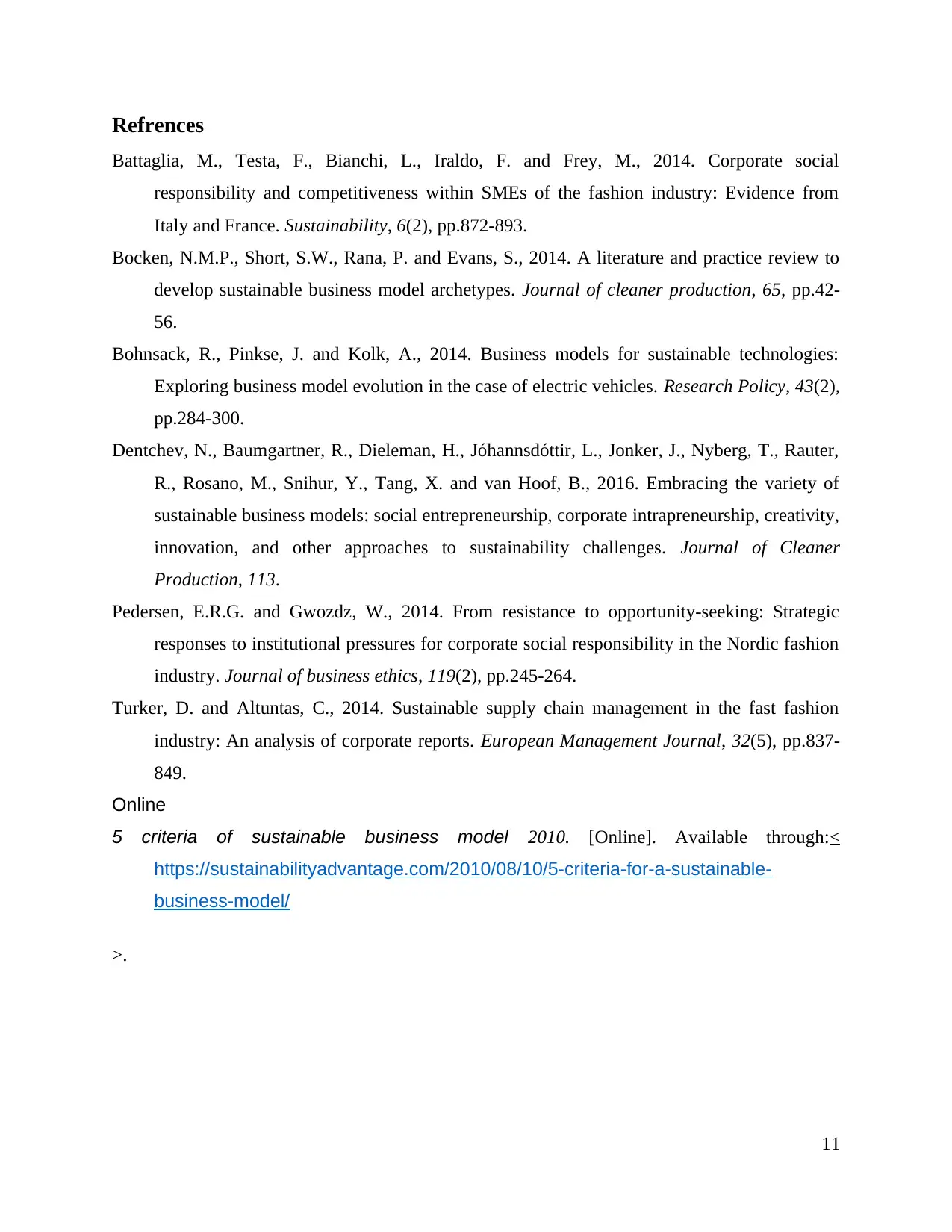
Refrences
Battaglia, M., Testa, F., Bianchi, L., Iraldo, F. and Frey, M., 2014. Corporate social
responsibility and competitiveness within SMEs of the fashion industry: Evidence from
Italy and France. Sustainability, 6(2), pp.872-893.
Bocken, N.M.P., Short, S.W., Rana, P. and Evans, S., 2014. A literature and practice review to
develop sustainable business model archetypes. Journal of cleaner production, 65, pp.42-
56.
Bohnsack, R., Pinkse, J. and Kolk, A., 2014. Business models for sustainable technologies:
Exploring business model evolution in the case of electric vehicles. Research Policy, 43(2),
pp.284-300.
Dentchev, N., Baumgartner, R., Dieleman, H., Jóhannsdóttir, L., Jonker, J., Nyberg, T., Rauter,
R., Rosano, M., Snihur, Y., Tang, X. and van Hoof, B., 2016. Embracing the variety of
sustainable business models: social entrepreneurship, corporate intrapreneurship, creativity,
innovation, and other approaches to sustainability challenges. Journal of Cleaner
Production, 113.
Pedersen, E.R.G. and Gwozdz, W., 2014. From resistance to opportunity-seeking: Strategic
responses to institutional pressures for corporate social responsibility in the Nordic fashion
industry. Journal of business ethics, 119(2), pp.245-264.
Turker, D. and Altuntas, C., 2014. Sustainable supply chain management in the fast fashion
industry: An analysis of corporate reports. European Management Journal, 32(5), pp.837-
849.
Online
5 criteria of sustainable business model 2010. [Online]. Available through:<
https://sustainabilityadvantage.com/2010/08/10/5-criteria-for-a-sustainable-
business-model/
>.
11
Battaglia, M., Testa, F., Bianchi, L., Iraldo, F. and Frey, M., 2014. Corporate social
responsibility and competitiveness within SMEs of the fashion industry: Evidence from
Italy and France. Sustainability, 6(2), pp.872-893.
Bocken, N.M.P., Short, S.W., Rana, P. and Evans, S., 2014. A literature and practice review to
develop sustainable business model archetypes. Journal of cleaner production, 65, pp.42-
56.
Bohnsack, R., Pinkse, J. and Kolk, A., 2014. Business models for sustainable technologies:
Exploring business model evolution in the case of electric vehicles. Research Policy, 43(2),
pp.284-300.
Dentchev, N., Baumgartner, R., Dieleman, H., Jóhannsdóttir, L., Jonker, J., Nyberg, T., Rauter,
R., Rosano, M., Snihur, Y., Tang, X. and van Hoof, B., 2016. Embracing the variety of
sustainable business models: social entrepreneurship, corporate intrapreneurship, creativity,
innovation, and other approaches to sustainability challenges. Journal of Cleaner
Production, 113.
Pedersen, E.R.G. and Gwozdz, W., 2014. From resistance to opportunity-seeking: Strategic
responses to institutional pressures for corporate social responsibility in the Nordic fashion
industry. Journal of business ethics, 119(2), pp.245-264.
Turker, D. and Altuntas, C., 2014. Sustainable supply chain management in the fast fashion
industry: An analysis of corporate reports. European Management Journal, 32(5), pp.837-
849.
Online
5 criteria of sustainable business model 2010. [Online]. Available through:<
https://sustainabilityadvantage.com/2010/08/10/5-criteria-for-a-sustainable-
business-model/
>.
11
1 out of 11
Related Documents
Your All-in-One AI-Powered Toolkit for Academic Success.
+13062052269
info@desklib.com
Available 24*7 on WhatsApp / Email
![[object Object]](/_next/static/media/star-bottom.7253800d.svg)
Unlock your academic potential
© 2024 | Zucol Services PVT LTD | All rights reserved.





